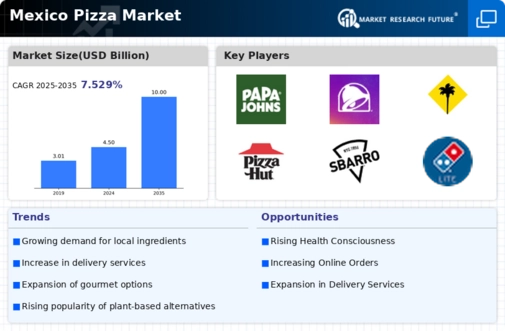The pizza market in Mexico exhibits a dynamic competitive landscape characterized by a blend of established players and emerging brands. Key growth drivers include an increasing demand for convenience, a shift towards online ordering, and a growing preference for diverse flavor profiles. Major companies such as Domino's Pizza (US), Pizza Hut (US), and Papa John's (US) are strategically positioned to capitalize on these trends. Domino's Pizza (US) focuses on digital transformation and delivery efficiency, while Pizza Hut (US) emphasizes menu innovation and local partnerships. Papa John's (US) is enhancing its brand image through quality ingredients and community engagement, collectively shaping a competitive environment that prioritizes customer experience and operational excellence.
In terms of business tactics, companies are increasingly localizing their supply chains to enhance responsiveness and reduce costs. The market structure appears moderately fragmented, with several key players holding substantial market shares. This fragmentation allows for a variety of consumer choices, while the collective influence of these major players drives competitive dynamics, fostering innovation and service improvements across the sector.
In October 2025, Domino's Pizza (US) announced the launch of a new AI-driven ordering system aimed at streamlining customer interactions and enhancing order accuracy. This strategic move is likely to bolster customer satisfaction and operational efficiency, positioning the company favorably in a technology-driven market. The integration of AI not only reflects a commitment to innovation but also aligns with broader trends in digitalization within the food service industry.
In September 2025, Pizza Hut (US) unveiled a partnership with local Mexican suppliers to introduce a new line of pizzas featuring regional ingredients. This initiative not only caters to local tastes but also strengthens supply chain relationships, potentially enhancing brand loyalty among Mexican consumers. By focusing on local sourcing, Pizza Hut (US) demonstrates a strategic commitment to sustainability and community engagement, which may resonate well with environmentally conscious customers.
In August 2025, Papa John's (US) launched a marketing campaign centered around its commitment to using high-quality, fresh ingredients, which included a series of community events aimed at rebuilding brand trust. This campaign is significant as it seeks to differentiate Papa John's (US) in a crowded market, emphasizing quality over price. Such initiatives may help the company regain market share and improve its competitive standing in the long term.
As of November 2025, current competitive trends in the pizza market are increasingly defined by digitalization, sustainability, and the integration of AI technologies. Strategic alliances, such as partnerships with local suppliers, are shaping the landscape by enhancing product offerings and fostering community ties. Looking ahead, competitive differentiation is likely to evolve from traditional price-based strategies to a focus on innovation, technology integration, and supply chain reliability, reflecting a broader shift in consumer expectations and market dynamics.


















Leave a Comment